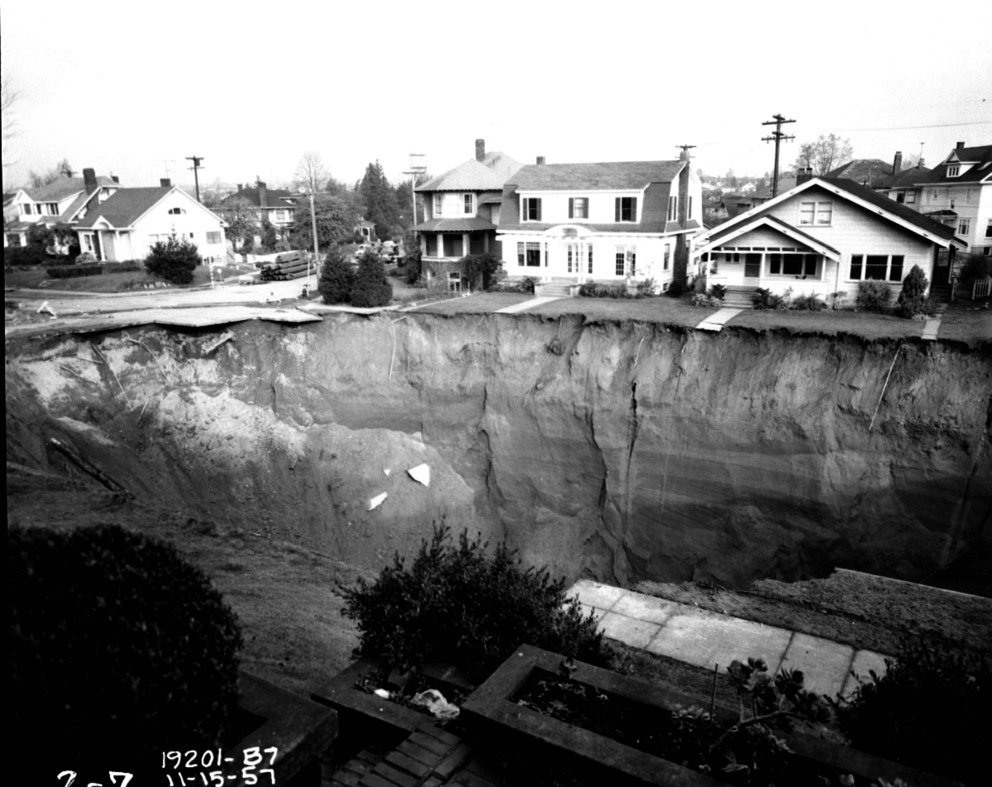When news broke about Bertha’s most recent holdup, it seemed like a new level of crazy. The giant tunnel-borer had created a massive sinkhole! Right downtown! Sure, I knew sinkholes are an issue in Florida, but I figured I was safe here. Is there something about Seattle's substrate that makes it susceptible to these things? Could we have seen this coming?
Well, it turns out this is far from the first time this has happened. Even in the last couple of months there have been other Seattle sinkholes: one in the middle of the road in Rainier Valley, and one that opened up between two homes in Queen Anne. This isn’t even the first time there’s been a sinkhole blamed on Bertha; the drill caused one that was 15 feet long, 20 feet wide, and 7 feet deep that raised “questions about the project” back in 2013.
And then there’s the sinkhole that was 3 stories deep in West Seattle in 2011, the sinkhole on the waterfront that trapped a 60-year-old man for about an hour in 2009, the sinkhole near the University Bridge that swallowed two cars in 2007 (and nearly another man but, thankfully, he managed to jump out of his van before it fell in), and the "great Ravenna sinkhole" of 1957, which was 50 feet deep, 120 feet wide, and more than 200 feet long—at the time, the biggest sinkhole of its kind, ever.
And you thought the Really Big One was a frightening prospect. Turns out the earth could open up at your feet and swallow you whole at any time.
So, what exactly is a sinkhole? It’s basically a depression in the earth’s surface or, more dramatically, a chasm that opens when the soil or rock beneath the surface has eroded away to form an underground cave. This can happen naturally, when the rock beneath is of a variety that water dissolves over time, like limestone, gypsum, or salt beds; in naturally forming sinkholes, rainwater seeps in and dissolves the rock over hundreds to tens of thousands of years.
A region characterized by this type of rock is called karst terrain—and karst covers a startling 20 percent of the country, including Florida, which is founded on limestone, and also Texas, Alabama, Missouri, Kentucky, Tennessee and Pennsylvania.
But Seattle was not built on karst. “We’re almost certainly talking about anthropogenic sinkholes here,” said George Veni, executive director of the National Cave and Karst Research Institute at New Mexico Tech, and chairman of the Sinkhole Conference, a biennial meeting of geologists, engineers and geologists about all things sinkhole (the next one is in 2018, should you be interested). Meaning, when it comes to open holes in Seattle—not technically sinkholes, but close enough that we’ll still call them that anyway—we have only ourselves to blame.
The cause and effect are pretty clear in the case of the Bertha sinkhole (the crew was too busy watching the machine and forgot to monitor the soil, Chris Dixon, head of Seattle Tunnel Partners, told Crosscut last week). Most of the other sinkholes that have formed in Seattle have to do with our aging underground water and sewer systems.
“Since these systems are pipes, they act like caves in the natural setting—a void beneath the surface,” U.S. Geological Survey geologist Randall Orndorff explained by email. When a crack forms in an old pipe, the surrounding soil seeps into it, thus creating a void above it. Man-made sinkholes can also happen when we do something that changes water drainage patterns, like build a parking lot.
The 2007 sinkhole near University Bridge was caused by a large broken water pipe. The sinkholes in 1957 (Ravenna) and 2011 (West Seattle) were caused by failed sewer pipes.
While we’ve had some sizable holes, it's hard to know how we stack up to other cities: There is no national sinkhole database. What we do know is that even in the past week, sinkholes have made headlines in cities across the country, including San Diego, Calif., Klamath Falls, Ore., and Savannah, Ga.
When it comes to sinkholes, we’re actually pretty lucky: “Cities like St. Louis, Nashville, Lexington—and pretty much any city in Florida has to deal with both infrastructure collapses as well as natural sinkholes that form in karst terrain,” Orndorff said.
According to a recent study by USGS research geologist David Weary, sinkholes in karst terrain alone cost the U.S. $300 million a year in repairs, not including the cost of damages to property like houses or cars. And Veni thinks that number is conservative.
If anything, anthropogenic sinkholes call attention to a fairly major issue that at some point we’ll be forced to address: our aging infrastructure nationwide. Seattle’s isn’t quite as old as cities like New York, Philadelphia or Washington, D.C., which are still using pipes from the 1800s, but a lot of it is still pretty old. Of the sinkholes I mentioned earlier, at least two were caused by pipes that were laid more than 100 years ago.
“If we do not start replacing or repairing our nation’s infrastructure, these events will keep occurring and most likely increase,” Orndorff said.
Meanwhile, if/when Bertha gets going again, it’ll have to drill through a section of particularly unstable soil. According to Dixon, it has 250 feet to go before it reaches the next “safe haven” near Yesler Way.
“The sinkhole is an unfortunate event,” Dixon said," but isn’t something that is unique or something that wasn’t anticipated."


